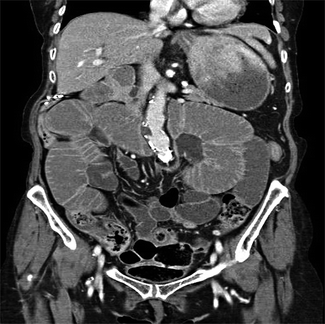Fig. 21.1
Classic X-ray finding of SBO-dilated small bowel with air–fluid level within the bowel. © Dale Dangleben, MD

Fig. 21.2
CT scan with extensive small bowel dilatation and fluid filled consistently with a distal small bowel obstruction. © Dale Dangleben, MD
Complications
The most common complication of adhesiolysis is inadvertent bowel injury. Iatrogenic injury could potentially occur upon entry in the abdomen or during lysis of dense adhesions. Full-thickness enterotomies should be repaired or resected with attempts to minimize contamination. The necessity of repairing serosal tears remains debatable.
Complete obstruction or vascular occlusion may lead to ischemia and ultimately perforation with risks of acute intraabdominal sepsis which needs quick diagnosis and prompt treatment.
Management
Fluid resuscitation is the mainstay of initial therapy. Electrolyte abnormalities should be corrected. Unless there is evidence of active ischemia or strangulation, antibiotics are generally not indicated. Nasogastric tube decompression and bowel rest have traditionally been used to relieve overdistension due to swallowed air and foregut secretions in all cases. More recently, patients with partial obstruction without nausea or vomiting have been nonoperatively managed with success without an NGT. Narcotic analgesia is used judiciously. In complete SBO, the classic teaching has been to operate early [3].
There is debate regarding the duration of nonoperative treatment of partial SBO until deciding to intervene surgically. Given the fact that 80% of adhesive bowel obstruction cases will resolve with a trial of nonoperative therapy, the decision making can be challenging. Recent retrospective studies have shown that 88% of cases will resolve within 48 h with the remaining cases resolving in 72 h. Most surgeons will wait 48–72 h before proceeding with operation. Others have advocated even longer times of up to five days before operating. Evidence of worsening exam or strangulation should prompt surgical intervention regardless of duration. Newer approaches to achieve early resolution have included upper gastrointestinal series with small bowel follow-through using water-soluble contrast if bowel obstruction is diagnosed previously on an unenhanced CT scan. Typically, surgery is indicated if no contrast is seen in the colon after 24 h. This protocol has been proven useful given the push to avoid the delays associated with CT scanning with oral contrast enhancement in emergency departments.
Stay updated, free articles. Join our Telegram channel

Full access? Get Clinical Tree








